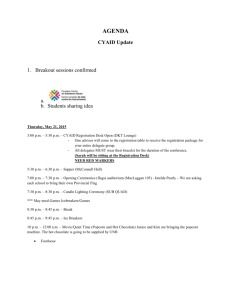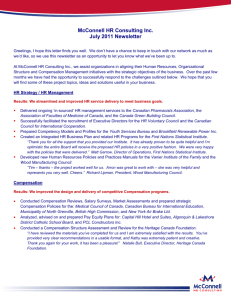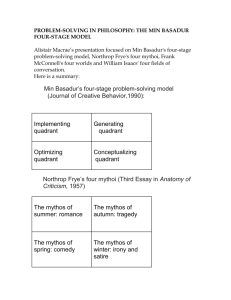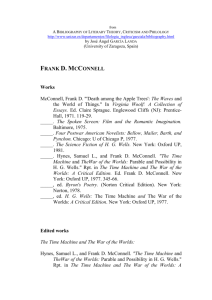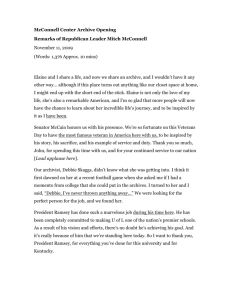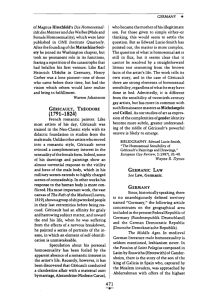View/Open
advertisement
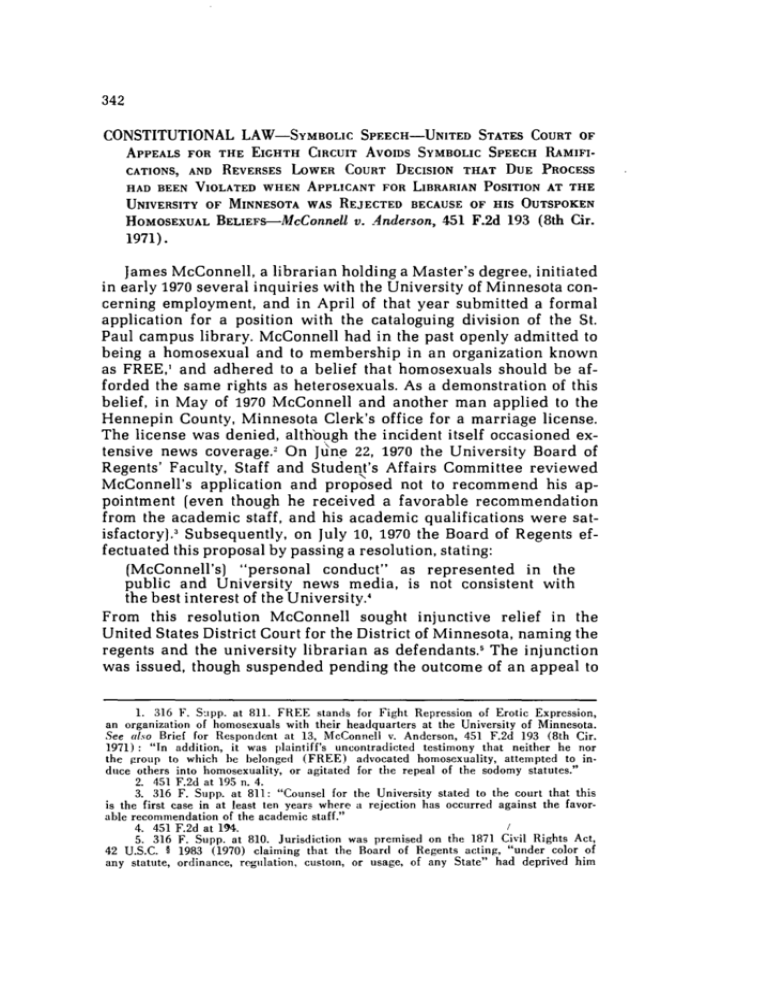
CONSTITUTIONAL LAW-SYMBOLIC SPEECH-UNITED STATES COURT OF APPEALS FOR THE EIGHTH CIRCUIT AVOIDS SYMBOLIC SPEECH RAMIFICATIONS, AND REVERSES LOWER COURT DECISION THAT DUE PROCESS HAD BEEN VIOLATED WHEN APPLICANT FOR LIBRARIAN POSITION AT THE UNIVERSITY OF MINNESOTA HOMOSEXUAL WAS REJECTED BECAUSE OF HIS OUTSPOKEN BELIEFS-McConnell v. Anderson, 451 F.2d 193 (8th Cir. 1971). James McConnell, a librarian holding a Master's degree, initiated in early 1970 several inquiries with the University of Minnesota concerning employment, and in April of that year submitted a formal application for a position with the cataloguing division of the St. Paul campus library. McConnell had in the past openly admitted to being a homosexual and to membership in an organization known as FREE,' and adhered to a belief that homosexuals should be afforded the same rights as heterosexuals. As a demonstration of this belief, in May of 1970 McConnell and another man applied to the Hennepin County, Minnesota Clerk's office for a marriage license. The license was denied, although the incident itself occasioned extensive news coverage.2 On June 22, 1970 the University Board of Regents' Faculty, Staff and Student's Affairs Committee reviewed McConnell's application and proposed not to recommend his appointment (even though he received a favorable recommendation from the academic staff, and his academic qualifications were satisfactory)., Subsequently, on July 10, 1970 the Board of Regents effectuated this proposal by passing a resolution, stating: (McConnell's) "personal conduct" as represented in the public and University news media, is not consistent with the best interest of the University., From this resolution McConnell sought injunctive relief in the United States District Court for the District of Minnesota, naming the regents and the university librarian as defendants., The injunction was issued, though suspended pending the outcome of an appeal to 1. 316 F. Sipp. at 811. FREE stands for Fight Repression of Erotic Expression, an organization of homosexuals with their headquarters at the University of Minnesota. See also Brief for Respondent at 13, McConnell v. Anderson, 451 F.2d 193 (8th Cir. 1971) : "In addition, it was plaintiff's uncontradicted testimony that neither he nor the group to which be belonged (FREE) advocated homosexuality, attempted to induce others into homosexuality, or agitated for the repeal of the sodomy statutes." 2. 451 F.2d at 195 n. 4. 3. 316 F. Supp. at 811: "Counsel for the University stated to the court that this is the first case in at least ten years where a rejection has occurred against the favorable recommendation of the academic staff." 4. 451 F.2d at 194. / 5. 316 F. Supp. at 810. Jurisdiction was premised on the 1871 Civil Rights Act, 42 U.S.C. § 1983 (1970) claiming that the Board of Regents acting, "under color of any statute, ordinance, regulation, custom, or usage, of any State" had deprived him 1972) RECENT CASES the eighth circuit court of appeals. The three-judge appeals court reversed the lower court, holding that it had erred in finding the Board's action to be "arbitrary, unreasonable, and capricious." McConnell v. Anderson, 451 F.2d 193 (8th Cir. 1971). In McConnell the United States Court of Appeals for the Eighth Circuit demonstrated a reluctance to extend the first amendment concept of symbolic speech to the conduct of an admitted homosexual - the court all but ignored the problem, deciding the case on the due process ground of what it found to be a very limited scope of review of this particular administrative body's actions. The federal district court, recognizing the case as one of first impression, determined that the Board's action in refusing to hire McConnell was unsupported by any rational nexus between McConnell's work performance and his admitted homosexuality and outward behavior. Although acknowledging the deference due the Board's discretion, the district court relied on a line of decisions from the United States Court of Appeals for the District of Columbia Circuit6 as indicating that in cases involving the dismissal of homosexuals by governmental agencies there must be some indication of impairment of performance or efficiency in relation to the employment - that homosexuality per se was not automatic grounds for dismissal. The court cited Dew v. Hallaby7 where the District of Columbia circuit upheld a dismissal by the Civil Aeronautics Board, but only after scrutinizing the evidence and determining that a foundation had been laid evidencing some relation between appellant's past homosexual conduct and his ability to "demonstrate qualities of character, stability, and responsibility." The importance of such a showing was reiterated in Norton v. Macy.8 There the same as a homosexual and as a citizen of the United States "of any rights, privileges, or immunities secured by the Constitution and laws," specifically the privileges and immunities and equal protection clause of the fourteenth amendment, and freedom of expression clause of the first amendment. 6. See 58 GEo. L. J. 632 (1970) for a discussion of these decisions. Judge Neville also cited Morrison v. State Board of Education, 1 Cal. 3d 214, 83 Cal. Rptr. 175, 461 P.2d 375 (1969), wherein the Supreme Court of California reversed the discharge of an employee by the State Board of Education. The court found there to be no evidence that appellant's private homosexual conduct impaired his "occupational fitness" as a teacher, and that a general assertion of "immoral conduct" was not sufficient. See also Scott v. Macy, 349 F.2d 182 (D.C. Cir. 1965). Here appellant was dismissed for "immoral conduct" premised solely on the allegation that he was a homosexual. The court indicated that the Commission failed to specify the conduct it found to be immoral and to indicate how his homosexuality impaired his "occupational competence or fitness." 7. 317 F.2d 582 (D.C. Cir 1963). Although the court ultimately deferred to the Civil Aeronautics Board's decision, it did so because the court lacked the experience to appraise appellant's homosexuality in view of the duties required of an air traffic controller. The court acknowledged that appellant's homosexuality might indicate the lack of stability to contend with the stress and pressure of this occupation and for that reason accepted the C.A.B.'s decision. 8. Norton v. Macy, 417 F.2d 1161 (D.C. Cir 1969). Here the court indicated that the evidence supported a finding that the appellant was a homosexual. However, since CREIGHTON LAW REVIEW (Vol. 5 court found that the reasons offered by the National Aeronautics and Space Administration for the dismissal of an employee were "unsubstantiated" in that they reflected general presumptions about homosexuality and the particular demands of the job. Based on these decisions, District Judge Neville in the principal case held: Though by current standards many persons characterize a homosexual as engaging in "immoral conduct," "indecent" and "disgraceful", it seems clear that to justify dismissal from public employment, or as the court finds in this case to reject an applicant for public employment, it must be shown that there is an observable and reasonable relationship between efficiency in the job and homosexuality .... An homosexual is after all a human being ... despite the fact that he finds his sex gratification in what most consider to be an unconventional manner. He is as much entitled to the protection and benefits of the laws and due process fair treatment as are others, at least as to public employment in the absence of proof and not mere surmise that he has committed or will commit criminal acts or that his employment efficiency is impaired by his homosexuality., Judge Neville did not pass on the question of "symbolic speech," but stated: Though there may be merit in such contention it is not necessary for the court to decide this nor any other alleged constitutional violation in view of the holding above relative to due process.'" On appeal, the court of appeals rejected the lower court's opinion, and upheld the Board's contention that that decision reflected a mistaken attempt to expand the scope of review of administrative decisions." Circuit Judge Stephenson observed that review was confined to a determination of whether the Board's action was arbitrary, unreasonable, or capricious. He rejected the lower court decision as exceeding that limitation, and found support for the Board's action by focusing on McConnell's public declaration of homosexuality and especially on the marriage license application, the appellant had previously demonstrated his competence and efficiency in performing this job, and that his homosexual activities were infrequent, the court found the National Aeronautics and Space Administration decision failed to meet the requirement that a dismissal be for "such cause as will promote the efficiency of the service." It appeared that NASA dismissed the appellant more out of custom than for any realistic reason. 9. 316 F.Supp. at 814. 10. Id. at 815. 11. See Brief for Appellants at 16, McConnell v. Anderson, 451 F.2d 193 (8th Cir. 1971). The court of appeals stated: "Rather than reviewing the Regents' action here to determine if arbitrary or capricious conduct could be found, the trial court set itself up as the final arbitrator on University employment matters and then proceeded to determine the matter on a de novo basis. In doing so it ignored the basic principles of the federal system and cast aside all traditional and legal restraints on judicial review of agency decisions." 1972) RECENT CASES which he characterized as "socially repugnant."'12 Judge Stephenson was apparently unmoved by the District of Columbia decisions, finding inconsistency with the "best interests" of the university to be the test for review, rather than the Dew and Norton "rational nexus" between the conduct objected to and job performance requirement. Although the court of appeals did not review McConnell's first amendment claim (it apparently was not raised on appeal), it is important to note Judge Stephenson's glancing rejection of McConnell's claim that his conduct and activities were communicative in nature and within the ambit of the first amendment concept of symbolic speech: In the District Court McConnell apparently argued that he has the right to apply for a marriage license and that such is "symbolic speech" within the protection of the Free Speech and Due Process clauses of the First and Fourteenth Amendments. He relies largely on Tinker v. Des Moines Ind. School Dist., 393 U.S. 503 (1969), a case from this circuit. Although this contention is not pressed here, we feel constrained to observe that we do not believe that Tinker, when read in light of its distinctive facts, can afford McConnell any comfort 3 in this regard.' The action by the district court and court of appeals in declining review of McConnell's first amendment argument does not abrogate the important constitutional question that was raised. Since both courts made explicit reference to this question it is appropriate at this juncture to examine the concept of "symbolic speech" and its constituent elements. The concept of symbolic speech has been accepted by the courts," but they have been reluctant to specify the limitations to which conduct must adhere to receive coverage under the first amendment. In dealing with communicative conduct the courts have applied the much used, much abused "balancing test," i.e., weighing society's interest in maintaining order against its need to permit free expression.'" Without the presence of a need for regulation the determination as to whether conduct classifies as speech is useless. Thus, the two foundational cases recognizing conduct as 12. 451 F.2d at 196. 13. Id. at 196 n. 7 (emphasis added). 14. Stromberg v. Calif., 283 U.S. 359 (1931) ; West Virginia State Bd. of Educ. v. Barnette, 319 U.S. 624 (1943) ; Garner v. Louisiana, 368 U.S. 157 (1961); Brown v. Louisiana, 383 U.S. 131 (1966) ; United States v. O'Brien, 391 U.S. 367 (1968) Tinker v. Des Moines Ind. School Dist., 393 U.S. 503 (1969) ; Saunders v. Virginia Polytechnic Institute, 417 F.2d 1127 (4th Cir. 1969). 15. See Note, Symbolic Conduct, 68 COLUM. L. REV. 1091 (1968). See also Emerson, Toward a General Theory of the First Amendment, 72 YALE L.J. 877 (1963); Comment, Flag Desecration as Constitutionally Protected Speech, 56 IOWA L. REV. 614 (1971) ; 58 Ky. L.J. 388 (1970). CREIGHTON LAW REVIEW (Vol. 5 knowing that he would be violating federal law.23 He contended that the law under which he was convicted was unconstitutional as an abridgement of his freedom of speech. Interestingly, although the Court rejected the idea that all conduct qualified as symbolic speech, it assumed, arguendo, that draft card burning might be speech, but emphasized that the government's interest in avoiding disruption of the selective service system was superior.2 - The guidelines enunciated by Chief Justice Warren were: (A) government regulation is sufficiently justified if it is within the constitutional power of the Government; if it furthers an important or substantial governmental interest; if the governmental interest is unrelated to the suppression of free expression; and if the incidental restriction on alleged First Amendment freedoms is no greater than is essential to the furtherance of that interest. 25 The Supreme Court again touched on the issue of symbolic speech in Tinker v. Des Moines Independent School District,' which involved the dismissal by the school district of three students who had worn black armbands as a protest against United States involvement in Vietnam. The petitioner's suit in federal district court was denied, 7 and that action subsequently affirmed by the eighth circuit. - The Supreme Court reversed, recognizing that such conduct was the type protected as symbolic speech under the first amendment.1 The court emphasized that the petitioner's conduct was done without violence, did not create any disturbance, and that the attempted regulation was intended more to ban the petitioner's conduct itself than as a precaution against possible disorder." A perusal of the aforementioned cases reflects that the Supreme Court has concerned itself more with when symbolic speech might be regulated and not with the question of when conduct itself becomes speech. When the Court has addressed itself to the latter 23. O'Brien was tried and convicted for knowingly violating 50 U.S.C. App. § 462() (3) (Supp. 1, 1965), amending 50 U.S.C. App. § 462 (1964), part of the Universal Military Training and Service Act. 24. 391 U.S. at 382. 25. Id. at 377. 26. 393 U.S. 503 (1969). 27. 258 F. Supp. 971 (1966). Petitioners based their jurisdiction allegations upon 42 U.S.C. § 1983 (1970), the same statte, relied upon by McConnell in the instant case. 28. 383 F.2d 988 (8th Cir. 1967). 29. 393 U.S. 503 (1969). For specific language of Justice Fortas, see text at note 47 supra. 30. 393 U.S. at 509. See, e.g., Saunders v. Virginia Polytechnic Institute, 417 F.2d 1127 (4th Cir. 1969). Here a student was refused readmission to the university for participating in a protest demonstration on campus. The fourth circuit, citing Tinker, stated: "A student's freedom to express peaceful dissent on campus is more than a privilege; Tinker tells us that it is a basic right guaranteed by the first amendment. A state university is powerless to restrict or deny it as long as it is not obstructive or disruptive." Id. at 1130. 1972) RECENT CASES speech and according it first amendment protection, Stromberg v. California'" and West Virginia State Board of Education v. Barnette, '7 did not really test the extent of first amendment coverage, as in both clearly the only basis for the state's interference was censorship'" - the symbolic speech involved was non-disruptive, consisting of waving a red flag and saluting. In Brown v. Louisiana,'8 however, a sit-in was staged in a public library as a protest against segregation. The protesters were convicted for breach of the peace. In contrast to the Stromberg and Barnette cases, here the state was exercising a legitimate police power, but still the Supreme Court overturned the conviction on the grounds that the situation did not warrant the exercise of that authority, and the convictions amounted to a violation of the protesters' right to free speech. Mr. Justice Fortas emphasized that the rights guaranteed by the first amendment are not limited to verbal expression, but include conduct which is intended to criticize unacceptable social policy: We are here dealing with an aspect of a basic constitutional right - the right under the First and Fourteenth Amendments guaranteeing freedom of speech and of assembly, and freedom to petition the Government for a redress of grievances .... As this Court has repeatedly stated, these rights are not confined to verbal expression. They embrace appropriate types of action which certainly include the right in a peaceable and orderly manner to protest by silent and reproachful resence, in a place where the protestant has every right to e, the unconstitutional segregation of public facilities. ° Thus, the majority in Brown laid major emphasis on both the communicative value of the petitioners' actions and the orderly manner in which it was accomplished.' In United States v. O'Brien2 2 the Supreme Court clarified the "balancing test" by establishing guidelines as to when the need for regulation might be paramount to permitting specific conduct to continue, even though that conduct involves symbolic speech. As a protest against the Vietnam War the defendant burned his draft card 16. 283 U.S. 359 (1931). 17. 319 U.S. 624 (1943). Justice Jackson stated: "There is no doubt that, in connection with the pledges, the flag salute is a form of utterance. Symbolism is a primitive but effective way of communicating ideas." Id. at 632. 18. See Note, Syibolic Conduct, 68 COLUM. L. REV. 1091, 1093-95 (1968). 19. 383 U.S. 131 (1966). 20. Id. at 141-42. 21. Id. at 151. Justice Black in dissenting emphasized that the state had primary interest in preserving order. Interestingly, Justice Harlan joined in this dissent. Previously in Garner v. Louisiana, 368 U.S. 157 (1961), a case also involving a sit-in in a restaurant, Justice Harlan wrote a concurring opinion in which he characterized the conduct as speech. Sec Note, Symbolic Conduct, 68 COLUM. L. REV. 1091, 1097 (1968). 22. 391 U.S. 367 (1968). GREIGHTON LAW REVIEW (Vol. 5 question it has looked to the communicative nature of the conduct involved. This requires a three-pronged showing that the conduct was intended to be expressive, that it stands out from normal activity, and that it is capable of being understood., This test has relevance where conduct has an established connotation. Problems arise, however, when conduct is void of any pre-determined meaning. When this occurs the courts should measure communicative content in terms of the function of free expression as outlined by Thomas Emerson: (1) As assuring individual self-fulfillment, (2) as a means of attaining the truth, (3) as a method of securing participation by the members of society in social, including political, decision-making, and (4) as maintaining the balance between stability and change in the society.32 Under this approach, conduct such as wearing a black armband,'3 picketing," sit-ins, 5 and hanging items from a clothesline" 6 can all possess communicative value, but this does not automatically bring such conduct under the protective umbrella of the first amendment. Having examined the interstices of symbolic speech, focus is again directed to the opinion of the court of appeals. First, was the analysis of the Board of Regents and the court of appeals as to the scope of review of administrative decisions sustainable? Second, did McConnell's conduct constitute symbolic speech, and if so, should it be protected by the first amendment? The Board of Regents rejected McConnell's application on the basis of his admitted homosexuality, especially his public attempt to secure a marriage license, stating that his employment was a potential source of embarassment to the university, and also that his conduct evidenced a violation of the Minnesota criminal code. The cases cited by the Board in its brief as indicating "embarassment" alone as sufficient grounds for dismissal of an employee by a government agency are distinguishable"7 - they all involved either a nexus argument or public criminal acts. It can be postulated further, that the question of whether McCon31. See Note, Symbolic Conduct, 68 COLuM. L. REV. 1091, 1109-17 (1968). See also Comment, Flag Desecration as Constitutionally Protected Symbolic Speech, 56 IOWA L. REV. 614, 621 (1971). 32. Emerson, Toward a General Theory of the First A4mendment, 72 YALE L.J. 877, 878-79 (1963). 33. See Tinker v. Des Moines Ind. School Dist., 393 U.S. 503 (1969). 34. See Edwards v. South Carolina, 372 U.S. 229 (1963). 35. See Garner v. Louisiana, 368 U.S. 157 (1961); Brown v. Louisiana, 383 U.S. 131 (1966). 36. See People v. Stover, 12 N.Y.2d 462, 240 N.Y.S.2d 734, 191 N.E.2d 272 (1963). 37. Schlegel v. United States, 416 F.2d 1372 (Ct. Cl. 1969), cert. denied, 397 U.S. 1039 (1960) : Jenkins v. Macy, 357 F.2d 62 (8th Cir. 1966) ; Vigil v. Post Office Department, 406 F.2d 921 (10th Cir. 1969); Taylor v. United States Civil Service 1972) RECENT CASES nell's outspoken homosexuality will potentially embarass the university has no relevance in the performance of his duties or his efficiency as a librarian. The point is the embarassment argument attains relevance in the main under the aegis of McConnell's first amendment right to voice his self-proclaimed homosexuality. The Board of Regents in their attempt to utilize these cases are admitting by implication that McConnell's first amendment rights must be regulated in order to preserve the University from ridicule. Judge Stephenson, utilizing a "best interests" test to the extent that McConnell's outspoken advocacy of homosexuality precluded his right to employment, has likewise raised first amendment questions far beyond the symbolic speech considerations - questions which are yet to be answered. Secondly, there was an absolute lack of proof that McConnell had engaged in sodomy in violation of the Minnesota criminal code, except by innuendo."8 For the Board of Regents to insist on the validity of their presumption that McConnell had or would engage in the crime of sodomy, considering there was no evidence to justify that presumption, and McConnell had emphatically denied having done so, is not only unfounded but tinges on being violative of his right to privacy as enunciated by the Supreme Court in Griswold v. Connecticut" and Stanley v. Georgia.' Judge Stephenson began his analysis by succinctly stating the breath of review of the Board's action: (A)t least with respect to matters purely administrative in nature, viz., the employment of University personnel and the like. the discretion of the Board necessarily is broad and Commission, 374 F.2d 466 (9th Cir. 1967). Both the Schlegel and Jenkins decisions are distinguishable because there was a nexus between the embarrassing conduct and the employment. The Vigil and Taylor cases are also distinguishable because dismissal of those cases was premised upon homosexual acts which occurred in public and for which the appellants were arrested and convicted under criminal statutes. 38. See Brief for Appellants at 19, McConnell v. Anderson, 451 F.2d 193 (8th Cir. 1971). After a discussion of the dictionary definition of "homosexuality" and of the phrase "living together" in modern usage, the attorneys for the regents concluded: "Under all these facts then it would appear that Regent Yn.,ve's conclusion as to the nature of the Plaintiff's activities [he had testified that the only conclusion he could draw from the facts was that the Plaintiff was engaging in activitics which are a crime under the laws of the State of Minnesota] is well supported under any reasonable interpretation of the facts and is not as the trial court suggests mere surmise. To hold otherwise is to require a direct admission front the Plaintiff or a camera in his living quarters. Moreover. Regent Ynewe's conclusion is confirmed by the Plaintiff's careful avoidance of any meaningful denial of participation in such activities." 39. 381 U.S. 479 (1965). 40. 394 U.S. 557 (1969). In both Griswold and Stanley the Supreme Court prohibited governmental intrusion into an indihidual's private life. In writing for the majority in Stanley, Justice Marshall stated that "also fundamental is the right to be free, except in very limited circumstances, front unwanted governmental intrusions into one's privacy." The Court then reversed a conviction for the private possession of obscene matter. Only if a state can demonstrate a "compelling subordinating interest" CREIGHTON LAW REVIEW (Vol. 5 subject only to such review as normally is available to litigants ... aggrieved by administrative action generally.,' Based upon this standard of review, Judge Stephenson applied the same test ennunciated by the Board of Regents and reversed the lower court: It is our conclusion that the Board possessed ample specific factual information on the basis of which it reasonably could conclude that the appointment would not be consistent with the best interests of the university.,2 The court's analysis of the Board's action in terms of a "best interest" test rather than Judge Neville's "nexus" test belies easy explanation. The court cites no direct authority applying the "best interest" test, and it fails to explain or differentiate it from the "nexus" test. (It must be noted here, however, that the embarassment possibilities to the university - whatever their merit - are of greater relevance when considered in light of the court's "best interests" test as opposed to the normal "nexus" test.) The only explanation for this lies in the court's analysis of the role of the regents in the management, control, and administration of the university. Judge Stephenson analyzes this role by resort to decisions of the Minnesota supreme court, and adopts the position taken by that court in Bailey v. University of Minnesota, 3 where it was stated: In its decisions throughout the years, this court has considered the nature and status of the university and its Board of Regents, and on several occasions has recognized the university's autonomous status and the very substantial deference to be accorded the governing authority of the regents."1 In light of the deference to be accorded the authority of the Board of Regents, Judge Stephenson's analysis in terms of a "best interest" test rather than a "nexus" test effectuates this purpose. However, it is significant to note that use of this test raises serious questions as to the precise scope of "best interests." Judge Stephenson satisfied the "best interest" test in McConnell by characterizing the case as one where a prospective employee is attempting to foist upon the university approval of "his unconventional ideas concerning the societal status to be accorded homosexuals" and the university should not have to accede to those ideas.41 This charactermay it interfere with one's privacy, and if such a prohibition is imposed on actual interference, then pfrhaps it is equally applicable to unfounded presumptions. See also In re Labady, 326 F. Supp. 924 (1971); Gayer v. Laird, 332 F. Supp. 169 (1971), in regard to the issue of homosexuality and the right to privacy. 41. 451 F.2d at 195 (emphasis added). 42. Id. at 196. 43. 187 N.W. 2d 702 (1971). 44. Id. at 704. 45. 451 F.2d at 196. As to any distinction between the due process test applied 1972) RECENT CASES ization may have viability in this unique fact situation, but the court's failure to set the parameters of the "best interest" test leaves the door open to varied interpretation in the future. Although the court of appeals was not required to consider McConnell's first amendment argument, it did in fact make a dispositive statement that Tinker when read in light of its distinctive facts would not afford McConnell any first amendment protection."6 The court's microscopic rejection of McConnell's argument is very tenuous when reviewed in terms of the nature of symbolic speech. McConnell, in challenging the traditional attitudes towards homosexuals, selected a means that most assuredly had communicative value in view of its novelty and its unambiguous presentation of his position. In terms of the function of free speech such conduct permitted McConnell not only to strive for individual fulfillment but to participate in challenging society to re-examine its treatment of homosexuals. Such conduct undoubtedly qualifies as symbolic speech. Furthermore, when balanced against any state interest for regulating this conduct (whatever its deep-rooted nature) there appears to be little justification for such interference. McConnell acted without violence or disruption; the license application itself was not violative of any law, and by challenging its denial he sought redress through legal means. The court's reliance on distinguishing Tinker on its facts and not analyzing McConnell's conduct from the standpoint of either its communicative value or the function of free expression is regretable considering the importance of the constitutional question raised. The Supreme Court in deciding Tinker never specifically limited its holding to the facts in that case. In fact, the importance of Tinker lies in the Supreme Court's very orderly analysis of symbolic speech and protection thereunder. The Court set the guidelines for their analysis in Tinker by stating: The school officials banned and sought to punish petitioners for a silent, passive expression of opinion, unaccompanied on hiring as opposed to firing, see Brief for Respondent at 5: Courts have long recognized that governmental agencies or subdivisions do not have absolute discretion in their hiring and firing policies. The obligation of government to accord due process sets at least minimal substantive limits on a governmental agency's prerocative to hire or dismiss its employees. Norton v. Macy, 417 F.2d 1161, 1164. While most of the cases considered hereinafter concern the due process obligation of governmental agencies in determining to fire an employee, the Constitution does not distinguish between applicants and employees, both are entitled to equal protection against arbitrary or discriminatory treatment by government. Scott v. Macy, 349 F.2d 182, 183. Chief Judge Bazelon, speaking in Scott, stated: Appellant is an applicant for public employment, and thus may have less statutory protection against exclusion than an employee. But he is not without constitutional protection. The. constitution does not distinguish between applicants and employees .... Id. at 183-84. 46. Id. at 196 n. 7. CREIGHTON LAW REVIEW (Vol. 5 by any disorder or disturbance on the part of petitioners. There is here no evidence whatever of petitioners interference, actual or nascent, with the school's work or of collision with the rights of other students to be secure and to be let alone. Accordingly, this case does not concern speech or action that intrudes upon the work of the school or the rights of other students." It's obvious from the above statement that the Court was not restricting the rationale of Tinker to its particular facts. The Court's strong and forceful language outlining the contours of symbolic speech can only be read as setting guidelines for determining when symbolic speech will be protected. The procedural stance of the symbolic speech argument, i.e., not needed for decision at the district court level and hence not specifically raised on appeal, mitigates to an extent the eighth circuit's treatment thereof. It nevertheless remains true that once the court felt "constrained" to comment, its analysis was too cursory to be beneficial. Joseph F. Furay - '72 47. 393 U.S. at 508.
